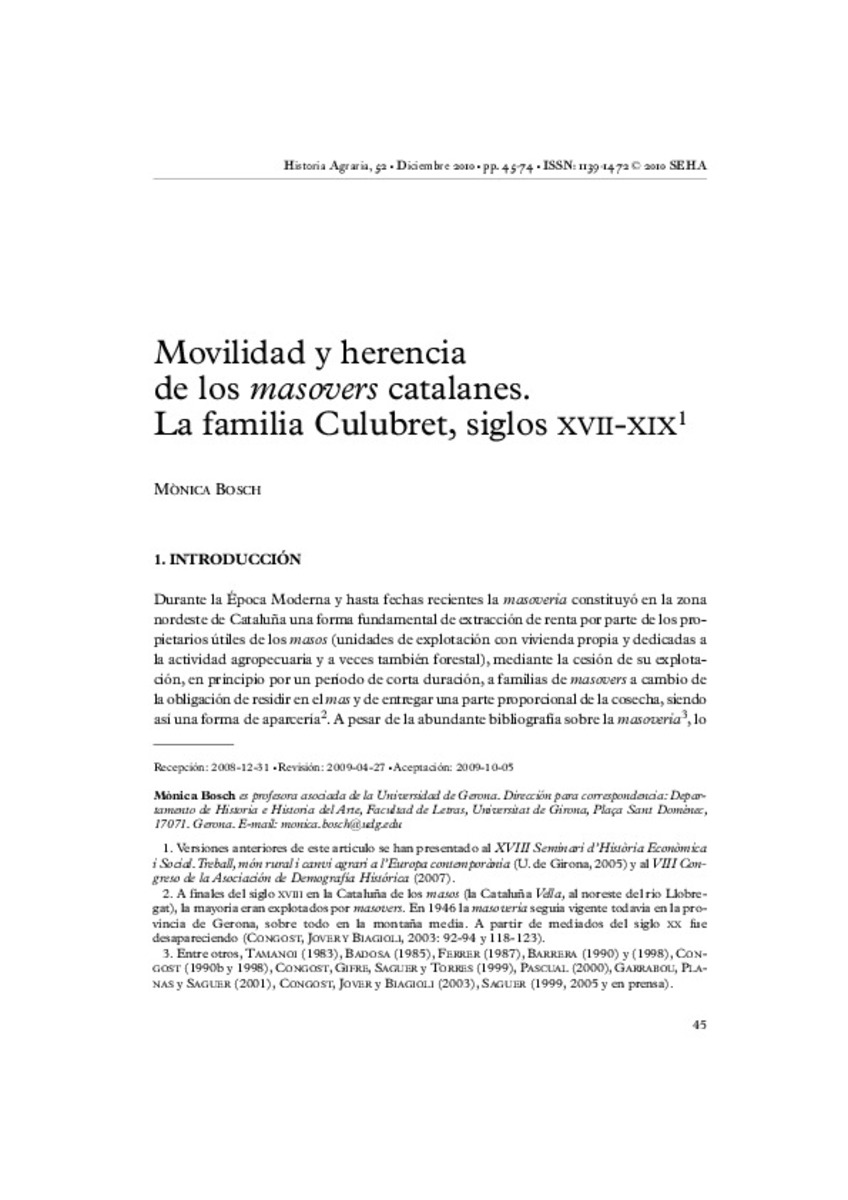Mostrar el registro sencillo del ítem
Movilidad y herencia de los masovers catalanes. La familia Culubret, siglos XVII-XIX.
| dc.contributor.author | Bosch, Mónica | |
| dc.date.accessioned | 2016-02-08T11:24:46Z | |
| dc.date.available | 2016-02-08T11:24:46Z | |
| dc.date.issued | 2010-12 | |
| dc.identifier.issn | 1139-1472 | |
| dc.identifier.uri | http://hdl.handle.net/10234/148893 | |
| dc.description.abstract | La reconstrucción genealógica de familias permite estudiar aquellos sectores agrarios que han generado poca documentación directa, como el de los masoveros (aparceros) catalanes. A partir de fuentes parroquiales, censos de población y protocolos notariales se ha reconstruido una familia de masoveros entre los siglos XVII y XIX. Su análisis permite abordar la lógica de los sistemas hereditarios, los movimientos de población, el grado de endogamia del grupo, sus limitadas posibilidades de ascenso social y el papel del mercado del crédito. El artículo concluye que el sistema de herencia universal e indivisible y de corresidencia intergeneracional de los masoveros -la mayoría sin tierras en propiedad- no fue resultado de una simple mimesis de los usos de la clase propietaria, sino de sus propias necesidades e intereses, en función de la estructura de la propiedad y las relaciones sociales y potenciado por los propietarios; que la movilidad de los masoveros era limitada y relacionada con el sistema de herencia; y que el mercado del crédito conectaba los mercados de la tierra y del trabajo. | ca_CA |
| dc.description.abstract | The genealogical reconstruction of families is a useful method tostudy those groups of peasants who have generated little direct documentation, such as the Catalan masovers (tenant farmers). Based on parish sources, population censuses and notarial records, a tenant farming family between the 17th and the 19th centuries has been reconstructed. This allows us to understand the logic behind the hereditary systems, the population movements, the degree of endogamy in the group, its limited possibilities for social promotion and the role of the credit market. The article concludes that the universal and indivisible inheritance and the intergenerational co‐residence practiced by the tenant farmers –most of them landless– was not the result of a simple imitation of the land‐owning class, but rather of their own needs and interests, ownership structure and social relations, and was strengthened by land owners; that the mobility of the tenant farmers was limited and related to the hereditary system; and that the credit market connected the land and labour markets. | ca_CA |
| dc.format.extent | 30 p. | ca_CA |
| dc.format.mimetype | application/pdf | ca_CA |
| dc.language.iso | spa | ca_CA |
| dc.publisher | Sociedad Española de Historia Agraria (SEHA) | ca_CA |
| dc.rights | © 2010 SEHA | ca_CA |
| dc.rights.uri | http://rightsstatements.org/vocab/InC/1.0/ | * |
| dc.subject | aparecería | ca_CA |
| dc.subject | masovería | ca_CA |
| dc.subject | mercados | ca_CA |
| dc.subject | sistemas hereditarios | ca_CA |
| dc.subject | movilidad | ca_CA |
| dc.subject | tenant farming | ca_CA |
| dc.subject | markets | ca_CA |
| dc.subject | hereditary systems | ca_CA |
| dc.subject | mobility | ca_CA |
| dc.title | Movilidad y herencia de los masovers catalanes. La familia Culubret, siglos XVII-XIX. | ca_CA |
| dc.type | info:eu-repo/semantics/article | ca_CA |
| dc.subject.jel | N33 | ca_CA |
| dc.subject.jel | N53 | ca_CA |
| dc.subject.jel | R23 | ca_CA |
| dc.rights.accessRights | info:eu-repo/semantics/openAccess | ca_CA |
| dc.relation.publisherVersion | http://historiaagraria.com/info_articulo.php?id=526 | ca_CA |







